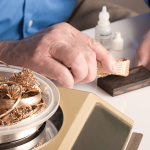Precious metals are measured in a different way than other materials, including a variety of specific measurement units for mass and purity.
Let’s look at the difference between troy and avoirdupois ounces, pennyweights, and carats when it comes to measuring metals.
Troy and Avoirdupois Ounces as Metal Measurements
The troy ounce originated as a system for measuring bronze currency in the Roman empire. One unit equaled a pound, and the Romans assigned 12 “unicas” (or ounces) to each pound.
Later uses of this system increased the pound to include 16 ounces, which came to be identified as an avoirdupois ounce, as “avoir de pois” meant “goods sold by weight” in Middle English.
The troy ounce is now an imperial unit of measure that is used only for precious metal measurements. One troy ounce equals 31.1034768 grams, while a single avoirdupois ounce is 28.349523125 grams, making the troy ounce heavier by almost 10 percent.
Pennyweight as a Precious Metal Measurement
Another common unit for measuring precious metals is the pennyweight, which began as a part if the troy weight system in England during the 15th century.
At that time, English pennies were precisely 1/20th of a troy ounce, which is why 20 pennyweights equal a single troy ounce, or 31.1 grams.
To help with calculating a price for your precious metals, you might want to use our pennyweight calculator and conversion chart. These tools will allow you to determine the value of your metals.
Grain as a Precious Metal Measurement
Grains are the smallest unit of precious metal measurement, and it’s not often used in the sale of gold, silver, platinum, or other metals, which tend to be valued in grams or troy ounces.
However, gold bullion companies have recently begun to take notice of the market for precious metal grain amounts. This is especially true when it comes to valuing pure gold bars, where a one grain gold bar weighs in at about .065 grams.
Carat as a Precious Metal Measurement
While the weight of gold is measured in troy ounces, its purity is calculated and quantified in karats (kt). In North America, the spelling is “karat,” but it is referred to as “carat” elsewhere in the world. This can be easily confused with another jeweler’s term – which is a unit of mass used to measure the weight of gemstones – also spelled as “carat,” as in “a two-carat diamond.”
Karats are determined by dividing the mass of the metal by the amount of gold within the metal and multiplying by 24. Twenty-four karats is equal to pure gold, 18kt is equal to 75%, 12kt is 50%, and so on.
Most countries have a legal karatage minimum for a metal to be sold as gold. In the United States, the accepted gold standard is 10 karats and above. In many parts of Europe, there’s a lower minimum gold standard of 8 to 9 karats.
Precious Metal Conversions
Most of the measurement units we’ve discussed can be converted into or out of one another. Take a look at the below precious metal conversions chart to learn more about how to find the value of your jewelry, coins, or bullion bars.












